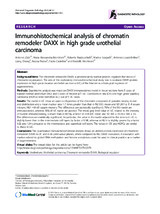Immunohistochemical analysis of chromatin remodeler DAXX in high grade urothelial carcinoma

Ver/
Autor
Zizzi, Antonio
Montironi, Maria Alessandra
Mazzucchelli, Roberta
Scarpelli, Marina
López-Beltrán, Antonio
Cheng, Liang
Paone, Nicola
Castellini, Paolo
Montironi, Rodolfo
Editor
BioMed CentralFecha
2013Materia
UrotheliumUrothelial carcinoma
Chromatin remodeler DAXX
Biological regulator
METS:
Mostrar el registro METSPREMIS:
Mostrar el registro PREMISMetadatos
Mostrar el registro completo del ítemResumen
Background/Aims: The chromatin remodeler DAXX, a predominantly nuclear protein, regulates the status of
chromatin organization. The aim of this exploratory immunohistochemical study was to evaluate DAXX protein
expression in high grade invasive urothelial carcinoma (UC) of the bladder as a biological regulator of
aggressiveness.
Methods: Quantitative analysis was made on DAXX immunostained nuclei in tissue sections from 5 cases of
bladder normal urothelium (NU) and 5 cases of bladder pT1 UC. Carcinoma in situ (CIS) and high grade papillary
carcinoma (HGPCa) were identified in 2 out of 5 UC cases.
Results: The nuclei in UC show an open configuration of the chromatin composed of granules varying in size
and distribution and a mean nuclear area 1.7 times greater than that in NU (UC: mean and SD 24.4 ± 11.4 square
microns; NU: 14.8 6.5 square microns. The differences are statistically significant). 70% of the NU nuclei are
immunostained, whereas 90% of UC nuclei are positive. The mean gray level value in UC, related to the intensity
of nuclear immunostaining, is lower than in NU by a factor of 0.94 (UC: mean and SD 100 ± 15; NU: 106 ± 15.
The differences are statistically significant). In particular, the value in the nuclei adjacent to the stroma in UC is
slightly lower than in the intermediate cell layers by factor of 0.98, whereas in NU it is slightly greater by a factor
1.02 and 1.04 compared to the intermediate and superficial cell layers. The values in CIS and HGPCa are similar
to those in UC.
Conclusions: The quantitative immunohistochemical analysis shows an altered protein expression of chromatin
remodeler DAXX in UC and in its preinvasive phases, when compared to NU. DAXX evaluation, if associated with
markers related to global DNA methylation and histone acetylation, could be used in clinical practice as a marker
of aggressiveness.
Virtual slides: The virtual slides for this article can be found here:
http://www.diagnosticpathology.diagnomx.eu/vs/1398457297102379
